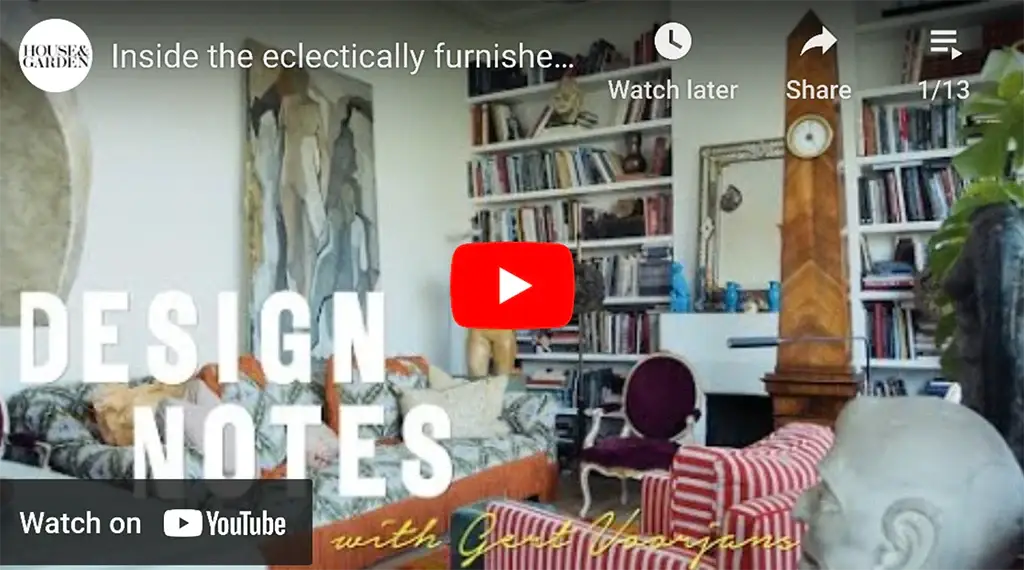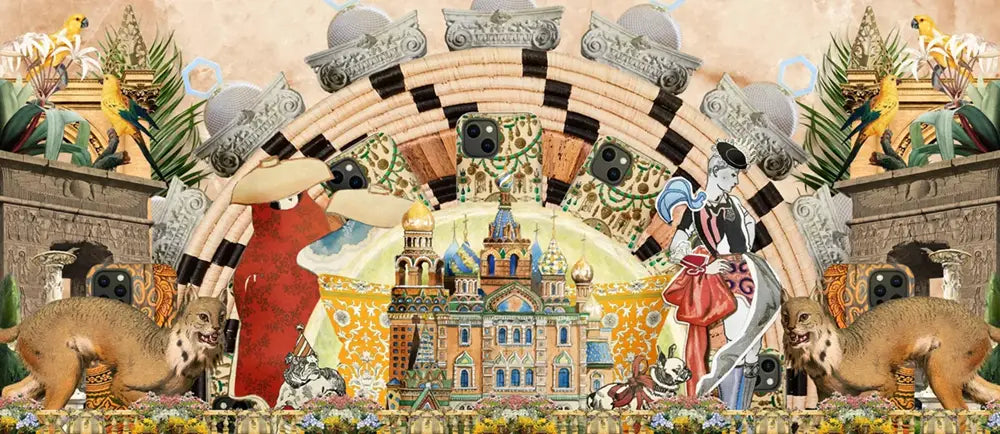A Moroccan lantern dangles in dappled shadow, casting filigree patterns across the buttery leather curve of an Eames lounge chair. This isn’t design—it’s a kind of alchemy. A deliberate disobedience. Here, the vocabulary of modernism converses with the baroque whisper of North African ornament, and the room responds not with clutter, but with character. This is the choreography of eclectic decor—where every object is a protagonist, every angle a thesis in contrast.
Eclectic home design isn’t about assembling a greatest hits of interior trends. It’s a ritual of recombination, a gathering of textures, eras, and influences into something fiercely autobiographical. One minute, a lacquered Japanese tansu chest hums beside a Memphis-style lamp. The next, Bauhaus geometry meets Shaker humility across a handmade Persian rug. Each pairing is unlikely. Each pairing works.
In a culture obsessed with minimalism and cohesion, eclectic interior design refuses to flatten identity into palette swatches. It’s maximalist with purpose, curated chaos. It winks at uniformity, then paints a mural across its face. Every mismatched chair, every rogue object d'art, becomes part of a deliberate grammar of expression. A stitched-together vocabulary of vintage finds, global accents, heirloom furniture, contemporary art, mid-century silhouettes, and artisan craftsmanship.
Today, the most intriguing interiors are not staged—they're inhabited. And the homes that resonate most deeply are the ones that reject showroom conformity in favor of personal mythology. Ahead, you’ll find practical guidance on how eclectic style transforms not just your living space, but your way of seeing—through balance, play, intention, and a fearless commitment to mixing and matching decor with emotional intelligence and visual rhythm.
Key Takeaways
-
Unchain Your Imagination: Eclectic style invites you to blend modern silhouettes with antique heirlooms, ensuring every corner radiates your singular story.
-
Balance Is the Secret Sauce: The goal isn’t chaotic clutter but carefully curated harmony—through color, texture, and proportion.
-
Global Influences Enrich the Narrative: Artifacts from Marrakech souks or Myanmar bazaars add layers of intrigue and cultural depth to any room.
-
Layering Textiles and Lighting for Warmth: Plush rugs, tactile throws, and an interplay of natural and artificial light generate irresistible comfort.
-
Embrace the Unexpected: A retro fridge beside a glass-top dining table? Yes! Mix and match with intention, letting each piece celebrate your eclectic spirit.
A Tapestry of Expression: Understanding the Basics of Eclectic Design

Eclectic design is not a free-for-all. It is an artful rebellion, a grammar of juxtaposition governed by intuition and coherence. At its most eloquent, eclectic interior design becomes a method of autobiographical storytelling—where Art Deco mirrors reflect Navajo patterns, and Victorian fainting couches lounge beside Lucite pedestals. Every choice, though unexpected, is calibrated. Every clash is a kind of chord.
At its heart, eclectic home decor rejects the monotony of uniformity in favor of a layered visual language. It doesn't chase trends—it curates memories, aesthetics, and atmospheres across eras. Think of it less as a collage and more as a fugue: interwoven motifs and motifs that resurface with variations. It draws on the past without replicating it, makes room for the present without defaulting to sterility, and forecasts futures rooted in personality, not Pinterest.
The principle of contrast is sacred here. A minimalist Scandinavian sofa becomes electric against the coarse grain of a tribal tapestry. A Bauhaus nesting table finds new dimension beside a carved Gothic revival bench. But this is not chaos—it’s calculated mischief. Eclectic design ideas rely on rhythm: repeated hues, mirrored shapes, spatial tension, and restraint. Yes, restraint. Maximalism, when curated with precision, avoids aesthetic fatigue.
To define eclecticism in home decor is to understand the tension between dissonance and cohesion. It’s not enough to toss together disparate pieces and declare the room “collected.” True eclectic design requires a narrative thread—be it tonal unity, thematic repetition, or the invisible logic of a lived-in sensibility.
Defining Eclecticism in Home Decor
Eclecticism in home decor is the conscious synthesis of decorative traditions. It marries brutalism with bohemia, minimalism with folk art, without succumbing to visual entropy. It’s not mood board mimicry—it’s a well-honed intuition for what sings together across time and geography. From postmodern angularity to French provincial warmth, each item earns its place not by matching, but by resonating.
This philosophy rejects the rigidity of stylistic silos. Where traditional interior design tips might urge cohesion through replication, eclectic styling finds unity in intentional dissonance. A striped mid-century armchair might sit beside a Ming dynasty end table—not as a punchline, but as a prelude to surprise.
Eclectic interiors conjure the sensibility of a collector, a curator, a traveler. Someone who knows how to mix materials—velvet with terrazzo, chrome with sisal—and doesn't apologize when a flea-market find shares the room with a high-design splurge.
The Do's and Don'ts of Eclectic Decorating
To master eclectic decorating, it's crucial to understand its fundamental do's and don'ts:
-
Do: Balance proportions. Allow each item breathing space. Diversity needs scaffolding.
-
Do: Integrate rich textures—mixing woodgrain, leather, glass, and wool adds tangible depth.
-
Do: Use color as connective tissue. A palette, even loosely defined, prevents fragmentation.
-
Don’t: Confuse randomness for eclecticism. Even the quirkiest choice must feel intentional.
-
Don’t: Prioritize beauty over usability. Good design still answers to function.
-
Don’t: Fear the edit. Subtraction can reveal harmony obscured by excess.
Eclectic design isn’t about maximalist bravado. It’s about interior alchemy. About mixing not just furniture and styles—but memory, culture, humor, and risk. About shaping a space that’s not just livable, but legible: a home that tells your story, in accents, angles, and unexpected pairings.
Starting With a Blank Canvas: Setting the Stage for Eclecticism
Every great eclectic interior begins not with abundance, but with absence. A room stripped of assumptions, washed in silence—its blank walls humming with possibility. This is not emptiness. It’s invitation. A blank canvas in eclectic home design functions like the overture of an opera: quiet, deliberate, charged with what’s to come.
To start with a blank slate is to allow yourself the freedom to listen—really listen—to what the space wants. Not impose, but interpret. Neutral floors and pale walls become a kind of architectural whisper, a grid where wild color, texture, and shape can later pirouette without cacophony. Here, restraint is not a compromise—it’s a compass.
This foundational emptiness is crucial to navigating the rich terrain of eclectic decor. Before layering the exotic with the industrial or pairing 1970s chrome with 19th-century mahogany, the room must offer space for these voices to converse. And to do that, the room must first exhale.
The Importance of Neutral Foundations
Walls function as negative space—blank yet alive. Think warm eggshell, matte clay, weathered limestone. These tones cradle contrast without shouting over it. A concrete floor can ground the theatrical sprawl of Turkish kilims; white oak underfoot invites contrast from distressed leather or vibrantly dyed dhurrie rugs. In this setting, bold accent walls and art pieces become punctuation, not static.
Floors, too, matter. Their tone sets the register. Dark wood suggests intimacy and gravitas. Pale tiles or terrazzo offer brightness and cool detachment. Whatever you choose, these foundations are not passive—they’re the primer for your design language.
Visualization and Planning
Don’t rush the populating of your space. Treat it as mise-en-scène, not furniture arrangement. Sketch. Walk the room. Note how light shifts from morning to dusk. Consider the rhythm of eye-level lines and ceiling height. Interior design tips always point to functionality, but here, function is secondary to flow. How does a viewer move through the room? Where do their eyes land and rest?
Visualize the synergy between forms: will a Bauhaus bookshelf echo the slant of your Barcelona chair? Can the rustic texture of salvaged wood mirror a sculptural pendant overhead?
A Step Towards Storytelling
Your first pieces should not scream. Let them murmur intention. A well-worn bench. A glass orb lamp. A linen-draped chair. These are your opening lines. With each addition—be it a tapestry from Oaxaca or a metal accent from Brutalist design—you build a lexicon.
Eclectic home decorating begins not with boldness, but with pause. Before you mix and match, you must listen, plan, and see. The blank canvas is not emptiness. It’s the promise of everything.
As you stand at the inception of your decoration adventure, remember that setting the stage for eclecticism is a deliberate and exhilarating process. In the embrace of a blank canvas, find the courage to be the artisan of your domestic realm, bringing together a multitude of disparate yet harmonious pieces that celebrate your individuality.
Color Schemes in Eclectic Interiors
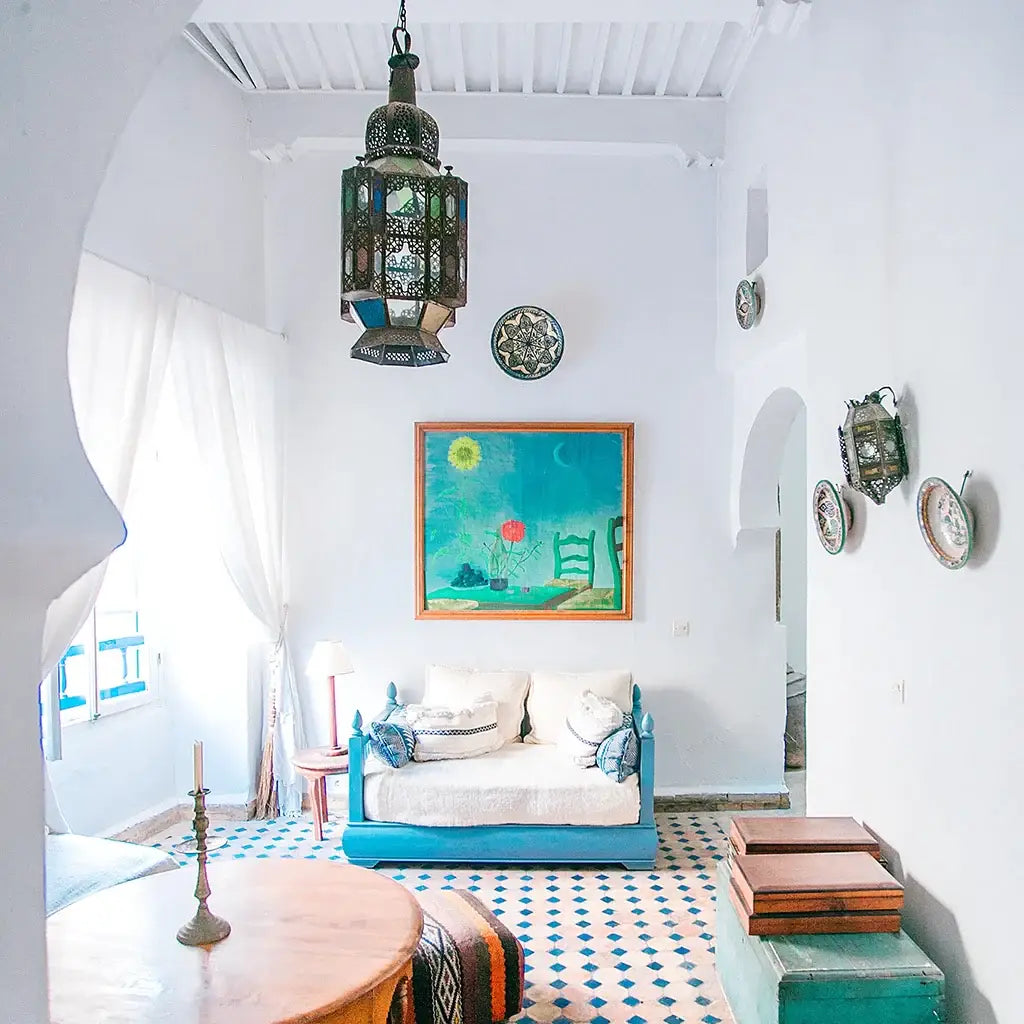
Imagine walking into a room where ochre cushions flirt with teal ceramics, where a vintage Persian rug tosses ruby and moss green across herringbone floors, and somehow—it all feels coherent. Color is the architect of emotion in eclectic interiors. It arranges contradiction into dialogue. It is the glue that binds your Brazilian teak credenza, your Bauhaus floor lamp, and your Shibori-dyed wall hangings into a single visual thesis.
In eclectic home decor, color is not just decorative—it’s strategic. It maps out spatial rhythm, defines emotional temperature, and offers connective tissue between clashing epochs and aesthetics. A thoughtful color scheme ensures that an Art Nouveau mirror and a Memphis Milano sofa don’t just coexist, but echo one another in chromatic harmony.
Bold and Subdued - Finding the Right Balance
Successful mixing and matching decor hinges on chromatic calibration. A room cannot shout in every direction. Begin with restraint: soft neutrals like bone, fog, sand, or sage offer a base layer of calm. These tones absorb noise. Then layer in vibrancy—crimson, citron, ultramarine—where tension is needed. A chartreuse velvet ottoman can become a visual exclamation point in a gallery-white room. A forest-green lacquered bookshelf anchors a wall filled with asymmetrical frames and found objects.
Start with one quiet tone: mushroom gray, blush, ivory, or matte indigo. Let that become the canvas. Then build complexity through color story: a pale terracotta wall that reflects the warm undertones of your kilim, or aubergine highlights that mirror a ceramic vase on the mantle.
Mood matters. Earth tones evoke grounding. Jewel tones conjure intimacy. Pastels whisper domesticity, while monochrome black and white sets a high-contrast stage for visual drama. Color does not merely fill space—it animates it.
-
Choose an anchoring neutral: eggshell, pale graphite, ash, or greige.
-
Infuse layers of interest with colorful accents—throw blankets, planters, book jackets, abstract prints.
-
Use bright hues in intentional punctuation: the single red chair, the cobalt side table, the lemon-yellow pendant.
-
Introduce darker shades for balance—bronze, matte navy, deep espresso—or cool metallics to modulate saturation.
-
Mind the saturation: too many competing brights flatten the space; contrast and spacing are key.
Using Color to Tie Diverse Elements Together
In eclectic interiors, color is diplomacy. It negotiates peace between competing patterns and disparate styles. A repeated tone—a coral thread, a deep ochre, a bottle green—creates subliminal cohesion across wildly different forms and materials.
Notice the crimson in your Turkish kilim? Echo it in a brushstroke on your canvas art or in the trim of a cushion. Find tonal symmetry between the rust of a terra cotta planter and the faded red in your Bauhaus poster. This is chromatic mirroring, and it’s what turns collection into composition.
-
Identify anchor hues in existing decor and subtly reiterate them in new additions.
-
Let natural materials like stone, rattan, and raw linen act as neutralizers amidst color chaos.
-
Use analogous colors (adjacent on the wheel) for softness, and complementary ones for energy.
-
Let metallics—copper, brass, pewter—play connective tissue between warm and cool schemes.
-
Consider zones: assign cooler palettes to quiet nooks and bolder schemes to communal areas.
The right color scheme doesn’t unify by sameness—it harmonizes through resonance. In the chromatic grammar of eclectic interior design, color is the syntax that makes contradiction fluent.
Furniture Selection for Eclectic Spaces
Choosing furniture for eclectic spaces is like casting a stage play where each actor comes from a different century, yet the chemistry must feel electric and seamless. A Victorian chaise lounges beside a molded plywood coffee table. A tribal drum doubles as a side table. The challenge isn’t just mixing—it’s composing. Your living room becomes both salon and archive, a place where antique furniture cohabits with modular design, and no piece is incidental.
At its best, eclectic home decor resists homogeny. It doesn’t flatten taste—it explodes it. This means the furniture selection for eclectic spaces must hold paradox: refined yet raw, contemporary but storied, cohesive without conformity. What binds these contradictions is not the pieces themselves but their interplay—how a Danish modern settee softens the rigor of a Brutalist concrete console, or how a Regency armchair recontextualizes a room bathed in Bauhaus linearity.
Begin by choosing a foundation—an anchor that stabilizes the room visually. It might be a sprawling velvet sectional, a distressed teak dining table, or a pair of mid-century slipper chairs. This foundational object is your gravitational force, setting the tone against which all other selections orbit.
Choose a signature style or era as a starting point, then layer contrasting styles to create depth.
You don’t need uniformity. You need an underlying current of aesthetic sensibility. Maybe it’s geometric forms. Maybe it’s warm wood tones. Maybe it’s brass accents that echo across disparate pieces. A coherent eclectic room is not a pile-up of impulse purchases—it’s a spatial essay where every object makes an argument.
Balance ornate furniture with simpler lines to avoid visual clutter.
Pair intricate Chinese Chippendale with Scandinavian minimalism. Match Rococo extravagance with postmodern starkness. Juxtaposition is the lifeblood of this decor philosophy—but balance is its heartbeat. Don’t overwhelm the eye with too many curves, carvings, or competing silhouettes.
Incorporate neutral pieces to temper the boldness of more eclectic items.
A simple linen settee or industrial bookcase provides visual breath. Let them frame bolder accents: an Art Deco mirrored cabinet, a neon acrylic bench, a curvilinear Lucite armchair. Think of these quieter pieces as intervals in a symphony—they give structure and rhythm.
Use color and texture to unify disparate furniture styles. A consistent palette can bring together a mix of antique and contemporary designs.
Connect your velvet bergère to your Eero Saarinen tulip table through a shared tone—perhaps both echo emerald or saffron. Use leather, boucle, marble, or matte black metal to stitch together conflicting periods.
Assess each potential piece for its practicality and comfort—eclectic does not have to mean impractical.
A Louis XIV chair may thrill, but will it support Sunday reading? An ultra-modern chaise may seduce, but can it host conversation? Function is never the enemy of aesthetic bravado.
-
Let utility and atmosphere share the stage.
-
Choose furniture that welcomes use—not just admiration.
-
Let your guests feel both intrigued and embraced.
Identify furniture that complements the space functionally and aesthetically, ensuring each item has a rightful place.
Furniture should engage with the architecture. A long credenza should mirror the length of a window. A curved sofa might echo the soft arch of a nearby alcove. A baroque armoire should not dwarf a low ceiling—scale is paramount.
Meld pieces from different design movements, such as mid-century modern with rustic, to add intrigue.
The tension between eras sharpens the room’s profile. A concrete plinth beside a Louis XVI fauteuil doesn’t jar—it jolts the room into coherence.
Look for common threads, like materials or finishes, to establish cohesion amidst diversity.
Carved walnut legs on a Victorian table? Let them reappear in a stool or mirror frame. Brass hardware on a retro cabinet? Repeat it in lighting fixtures or even drawer pulls.
Opt for high-quality construction and timeless design to ensure longevity of eclectic pieces.
Flimsy construction undermines the integrity of the mix. Invest in craftsmanship, not just quirk.
Consider scale and proportion; larger rooms can handle more substantial or numerous pieces, while smaller spaces benefit from fewer, more impactful selections.
Big or small, a space thrives on visual cadence.
Furniture in eclectic interiors is not passive; it is performative. Each piece should provoke thought, carry memory, invite interaction, and sit in dialogue with everything around it. When chosen deliberately, placed intuitively, and balanced precisely, furniture selection becomes the architecture of eclectic style itself.
Vintage Meets Modern - A Furniture Fusion
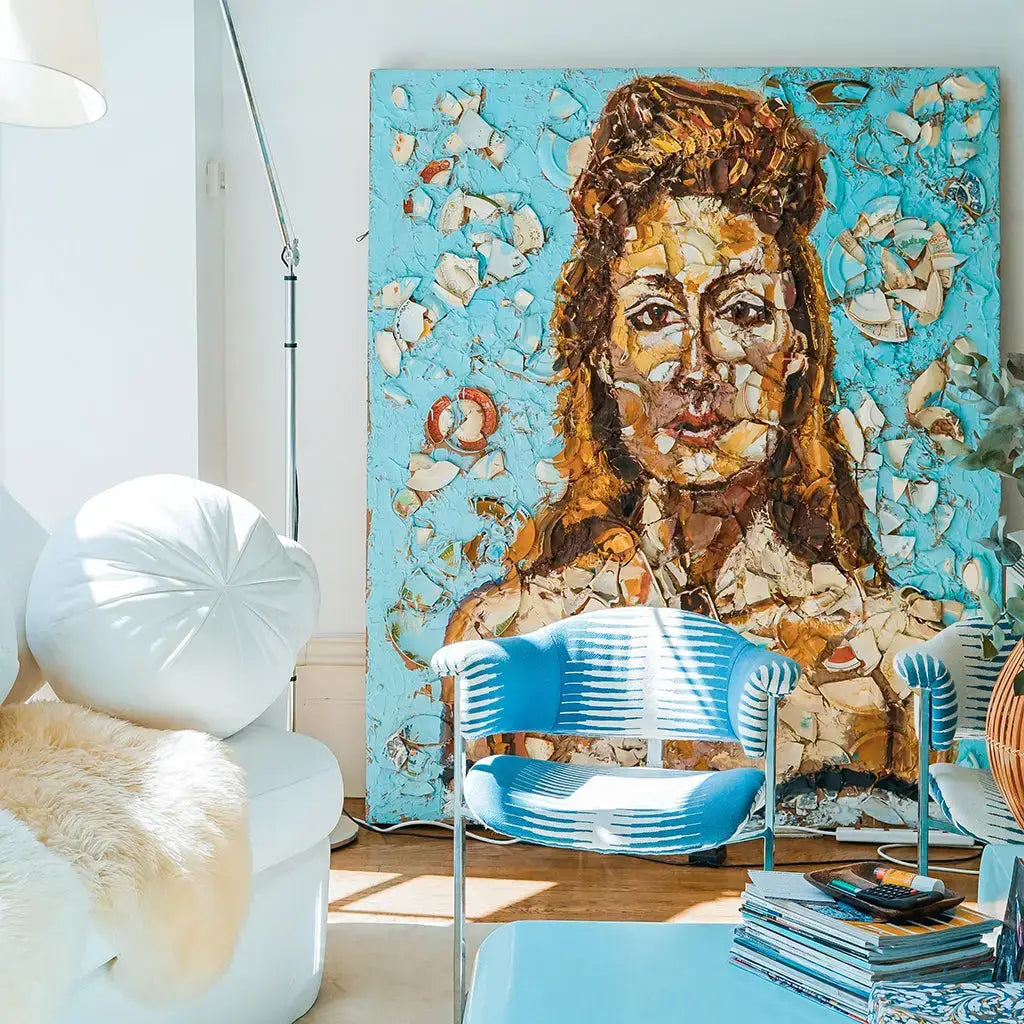
The magic of eclectic decor often crystallizes in the bold friction between eras. It’s where patina meets polish. Where the gilded detail of a Louis XVI fauteuil finds itself harmonizing—almost miraculously—with the slick austerity of a Marcel Breuer cantilever chair. This isn’t nostalgia versus futurism. It’s fusion. And when done with finesse, the result is a space that pulses with aesthetic tension and curated contrast.
In the language of eclectic interior design, this union of vintage meets modern becomes a signature dialect. It allows a 1970s mirrored coffee table to sit coolly beside an Edwardian roll-top desk, neither dominating, both conversing. Vintage pieces bring depth, narrative, and material honesty—weathered wood, aged leather, hand-turned brass. Modern pieces offer architectural precision, clean geometry, ergonomic subtlety. Together, they strike a chord that feels simultaneously grounded and forward-looking.
To execute this furniture fusion successfully, you need to think in terms of dialogue, not dominance. Let the modern be the exhale to the vintage’s inhale. Consider juxtaposition as a method of balance—not visual chaos.
Choosing Statement Pieces for Impact
A statement piece should not scream across the room. It should hum with gravity. The eye should settle there, magnetized by its form, its silhouette, or its history.
-
Select one bold vintage piece—perhaps an antique armoire or a Victorian fainting couch—and allow it to hold court against the restraint of your contemporary surroundings.
-
Alternatively, let a modern sculpture or minimalist daybed provide visual relief amidst ornate relics.
-
Play with proximity: place a distressed wood console against a minimalist white wall. Hang a high-gloss contemporary artwork above a tufted, camelback sofa.
-
Use spatial breathing room around these pieces to elevate their presence. Don’t crowd a 19th-century cabinet with equally demanding décor. Let it stand and speak.
Select a vintage piece with a rich history, such as a classic Eames lounge chair, and let it stand out against minimalistic decor.
That chair doesn’t just offer design clout—it holds cultural capital. Pair it with a neutral flatweave rug, a Bauhaus coffee table, and a moody palette of muted greens and umbers to anchor the room in reverence.
Incorporate modern light fixtures above an antique dining table to illuminate the room and highlight the fusion of eras.
Think sculptural LED pendants in matte black or brushed brass suspended over a mahogany trestle table. It’s not just contrast—it’s cinematic lighting design.
Seek out vintage statement pieces that boast timeless design and craftsmanship, ensuring they’ll remain focal points as trends evolve.
Let that hand-carved cabinet or milk-painted hutch defy obsolescence. Good craftsmanship is a permanent invitation to gaze.
Boldly mix materials and textures; pair the soft patina of aged wood with the cool edge of metal or glass to add a tactile dimension.
Marble and rattan. Polished steel and velvet. The eye craves variety—so feed it, but don’t overindulge.
Contemplate how each furniture piece will contribute to the room's aesthetic and function before making a commitment.
Design isn’t just an art—it’s an ethic. A good piece must earn its place.
When you achieve equilibrium between the antique and the avant-garde, you create more than visual intrigue—you compose a narrative that honors both heritage and experimentation. This is not fusion for novelty’s sake. It’s a layered interior philosophy that keeps your home in aesthetic conversation across centuries.
Accessorizing in Eclectic Decor
Accessories are not afterthoughts—they are punctuation marks, rhythm-makers, and mood-setters. In a room that marries Victorian silhouettes with Bauhaus angularity, it’s the objects that fill the space between that either sing or stutter. To master eclectic decorating, one must treat accessories as both curator and choreographer would: each item chosen not for convenience but for narrative clarity.
Accessories tell the subplots. A hand-carved African mask above a Danish credenza. A ceramic jug from Oaxaca on a Memphis-inspired shelf. A brass telescope, non-functional but poetic, resting beside a Baule stool. These objects are more than decorations. They are anchors of emotion and flashes of memory. Their power lies not in cost or provenance, but in placement and personality.
In eclectic interior design, accessories perform a rare double act: they unify and diversify. A Moroccan lantern might bridge the mood between a mid-century armchair and a brutalist concrete side table. A vintage globe and contemporary sculpture may share a shelf, but their juxtaposition creates harmony when bound by similar tones or repeated materials. It is a visual equation with objects as variables.
Consider the Scale and Proportion of each accessory in relation to the room and furnishings. A solitary large sculpture atop a console may provide presence, but so can a trio of smaller items arranged in graduated height. Avoid the trap of visual noise—let silence and spacing do their work, too.
Mix Textures and Materials to add depth and intrigue. Think feathered juju hats beside lacquered trays, or matte porcelain vases beside hammered copper. In the language of accessories, contrast equals chemistry.
Integrate Cultural Elements that are meaningful to you. Ethnographic pieces, textiles gathered on travels, heirloom curios—when placed with care—elevate eclectic home design from aesthetic exercise to deeply personal manifesto. Meaning imbues material with magnetism.
Group Items Thoughtfully. Odd numbers often feel more natural to the eye. Consider thematic alignment (nautical, botanical, spiritual), or establish relationships through tone and finish. Items don’t need to match—they need to speak.
Edit and Curate to avoid overcrowding. Let objects breathe. Not every surface must be filled. Subtraction sharpens focus. Rotate items seasonally, or let certain accessories rest and return when the energy of the space shifts.
Try clustering unexpected combinations: a stack of surrealist art books beside a carved fetish figure and an iridescent Murano glass bowl. Then step back and observe what emotion the arrangement stirs. If your shelf tells a coherent mood, you’ve succeeded.
Accessories are often underestimated, yet they’re the emotional connective tissue of eclectic decorating. They fill the negative space with narrative. They give rooms a pulse, a dialect, a sense of humor. With the right intention, a room accessorized well can feel like a sentence finished, not overstuffed but well-spoken.
By selecting pieces with both aesthetic tension and sentimental resonance, you create rooms that don’t just look lived-in—they feel lived-through. This is the heart of eclectic home decor: not just the meeting of styles, but the layering of meaning.
Art and Ornaments - Personalizing Your Space
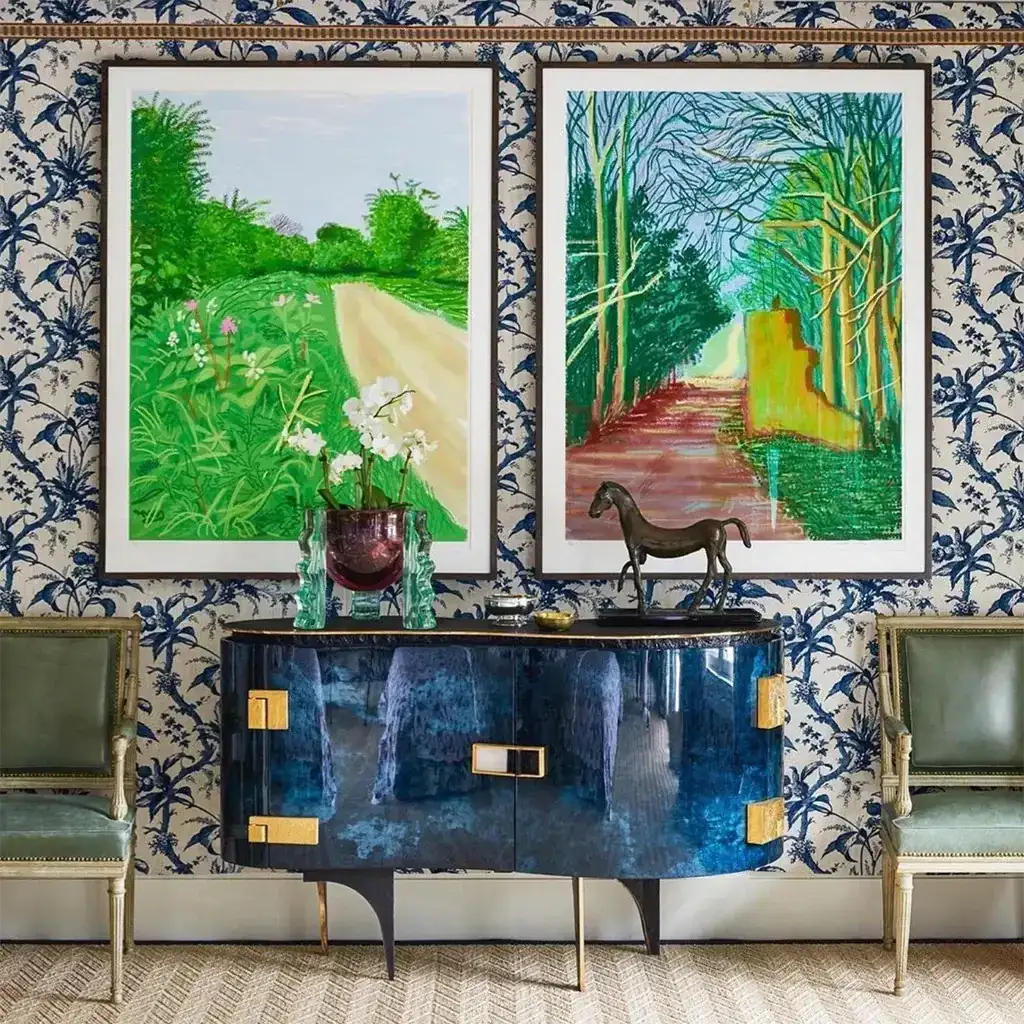
@RichardMishaan for the Galerie House of Art and Design
Art and ornaments aren’t embellishments—they are emissaries. They signal memory, identity, and defiance of the sterile showroom aesthetic. This is where a hand-stitched textile from Gujarat might hang beside a pop-art canvas; where an inherited porcelain figurine can coexist with an androgynous bronze bust. Each piece plays a role in your home’s ongoing autobiography.
Eclectic decor thrives on contradiction made coherent, and nowhere is that more potent than in the art we choose to live beside. A curated gallery wall mixing 19th-century etchings, postmodern abstracts, and candid black-and-white photography speaks volumes—not only of your taste, but of your temporal loyalties. You’re not decorating a room. You’re composing a visual memoir.
Storytelling Through Decorative Pieces
Every object is a chapter, and every chapter needs cadence. This isn’t about filling walls or stuffing bookshelves. It’s about resonance. About finding objects that feel like internal punctuation—an exclamation, a pause, a whispered aside.
-
Reflective Choices: Start with what matters. A print bought on honeymoon. A lithograph passed down generations. A ceramic tile that survived a move across continents. Sentimental gravity should trump aesthetic perfection.
-
Global Narratives: Ethnographic art, tribal statuary, or Buddhist thangkas—these pieces are more than travel souvenirs. They collapse borders inside your home, infusing it with global interior design influence. Let them exist not as trophies but as dialogue partners.
-
Eclectic Harmony: Don’t aim for uniformity. Pair oil paintings with risograph prints, Brutalist sculptures with rococo figurines. Let hierarchy dissolve. It’s not about cost, it’s about conversation.
Displaying Art: Composition matters. Consider a common tonal thread, shared framing, or a radial layout to prevent chaos. Try salon-style arrangements for drama, or asymmetrical grids for tension. Grouped artworks don’t need thematic alignment—but they need rhythm. A space with too many focal points loses its story.
Adding Ornaments: These are your peripheral storytellers. A woven talisman on a doorknob. An amethyst geode on the entry table. An antique typewriter repurposed as a sculpture. Use vertical space: wall-mounted shelves, corner plinths, bracketed display boxes. Let every surface speak without shouting.
Layering Textures: Juxtapose slick porcelain with matte ceramics, glazed tiles with unfinished stone. Mix patinated metal with lacquered wood. A well-layered surface evokes intimacy—it invites the eye, and the hand, to linger. Don’t underestimate touch as a tool of emotional design.
The secret to personalizing space with eclectic art lies not in quantity, but in curation. Rotate pieces the way a gallerist might. Edit without apology. Let objects fall in and out of rotation like seasons. The goal is not stasis, but resonance. Your collection should evolve as you do.
Art and ornaments are the emotional cartography of a home. They trace your aesthetic topography and psychic landscape. In eclectic interiors, they’re more than décor—they’re declarations.
Layering Textiles for Depth and Comfort
Textiles are both the costume and the script. They create atmosphere before a word is spoken—beckoning bodies, softening edges, absorbing sound, suggesting intimacy. To master the art of layering textiles for depth and comfort, one must become fluent in texture and tension. Every woven throw, tufted rug, and slubby curtain becomes a character in the sensory experience of the room.
Eclectic spaces aren’t sterile galleries. They’re lived-in sanctuaries. And textiles are the connective tissue that make eclectic rooms habitable, not just admirable. They give your interior language—embodied, visceral, poetic. Think of layering as a choreography of surface, weight, and drape: a silk pillow beside a jacquard blanket, a velvet bench skirt brushing against a jute rug.
Add sumptuous layers to sofas and beds with a mix of throw pillows in various sizes and designs, considering both visual impact and the plush comfort they offer.
Play with contrast: large linen bolsters next to crushed velvet squares, geometric prints beside painterly florals, monochrome against embroidery. Eclectic home decor demands a pluralistic texture palette.
Introduce rugs that vary in texture and pattern to outline or unite different areas in a room, providing comfort underfoot and a feast for the eyes.
Overlay a vintage Persian on a sisal base. Try a cowhide angled over a faded kilim. Use rugs not just for utility, but as zoning tools—to delineate reading corners, dining spaces, or intimate nooks within open-plan rooms.
Combine light and airy curtains with heavier drapes to play with light and shadow, crafting an inviting ambiance that changes with the time of day.
Sheer cottons let in morning glow; velvet panels frame it in the evening. For bonus texture, consider Roman shades layered beneath ceiling-height drapes, adding depth and architectural emphasis.
Blending upholstery fabrics on furniture can create a sense of unity despite diversity, harmonizing disparate styles within your eclectic decor.
Mix boucle and leather, denim and linen, chenille and raw silk. Don’t confine yourself to standard upholstery rules—consider slipcovers in rotating seasonal textiles, or mismatched dining chairs upholstered in coordinated but non-identical fabrics.
-
Begin with a neutral base: oatmeal-toned sofa, ivory bedding, or a natural jute rug.
-
Introduce a middle layer of accent fabrics—throws, cushions, poufs—in warm tones or contrasting motifs.
-
Finish with top notes of visual interest: a handwoven wall hanging, a fringed canopy, or a patchwork quilt that tells a story.
Textiles in eclectic interiors don’t just serve function. They evoke lineage, culture, craft. A Sumi-dyed linen curtain speaks of Japanese restraint. A Moroccan cactus silk pillow adds shimmer and history. A Welsh tapestry brings the logic of heritage into the now.
By layering textiles intentionally—varying thickness, opacity, pattern, and scale—you build not just comfort, but complexity. A room swathed in fabric becomes a room that breathes, exhales, sighs. In a world increasingly dominated by cold, glossy surfaces, the tactile, the woven, the hand-stitched speaks volumes.
Lighting in Eclectic Interior Design
Lighting doesn’t simply illuminate—it orchestrates. It is the unseen designer, the mood-setter, the punctuation mark in a sentence of space. A room layered with eclectic home decor must be lit with equal complexity, where shadows speak as boldly as fixtures. Light is not a background element. It’s an active participant in the room’s narrative.
To mix and match decor effectively, lighting must bridge periods and temperaments. Imagine a Deco-era sconce humming beside a Sputnik chandelier; an antique pharmacy lamp anchored beside an LED halo. This is not contradiction—it’s counterpoint. Each piece brings its own gravitational pull.
Mixing Lighting Styles for Dramatic Effect
Think of your lighting plan as a tiered composition. Ambient light creates atmosphere. Task lighting sculpts function. Accent lighting introduces theater. In eclectic interiors, layering these modes using stylistically varied fixtures enhances both form and feeling.
-
Pair an industrial tripod lamp with a Rococo side table.
-
Suspend a minimalist globe pendant above a salvaged butcher block dining table.
-
Let a Murano glass chandelier drip elegance into a room punctuated by brutalist artwork.
-
Cluster lantern-style pendants above a modernist kitchen island.
-
Introduce sculptural lamps—ceramic torsos, hammered metal totems, vintage lava-glass domes—as design elements in their own right.
Light, like furniture, must have personality. Select fixtures that cast evocative shadows. Choose bulbs for warmth—4000K and under—so the room glows, not glares.
Use mirrors not merely for function but for amplification. An ornate mirror placed behind a table lamp multiplies light while reflecting ornament. A smoked glass surface beside a window doubles your daylight. Lighting becomes kinetic when paired with reflective surfaces.
The Role of Natural Light in Eclectic Spaces
Natural light is the most democratic designer—it flatters everything it touches. In a room filled with visual stimuli, it adds balance and spaciousness. Yet it’s not just about windows—it’s about directionality, diffusion, and reflection.
-
Position mirrors opposite south-facing windows to magnify brightness.
-
Layer window treatments—linen sheers beneath velvet panels—to control intensity and mood throughout the day.
-
Use glass-topped furniture to let light pass through rather than stop.
-
Introduce semi-reflective finishes—lacquered cabinets, metallic wallpapers, polished stone—that bounce and blur sunlight in unpredictable ways.
If your space lacks natural light, emulate it. Choose full-spectrum bulbs or install skylight-style fixtures that mimic daylight’s vertical descent. Think beyond overhead: wall washes, picture lights, under-cabinet LEDs—all add nuance.
Ambient glow can be reimagined through creative placement. Backlight a bookcase. Highlight a sculpture. Drape a strand of vintage Edison bulbs across a beam or canopy bed.
Good lighting in eclectic interiors is not about matching. It’s about intention. It turns a reading corner into a sanctuary, a hallway into a gallery, a dining room into a conversation stage. Done well, it makes the entire space feel choreographed—alive with light and shadow.
Eclectic Style in Different Rooms
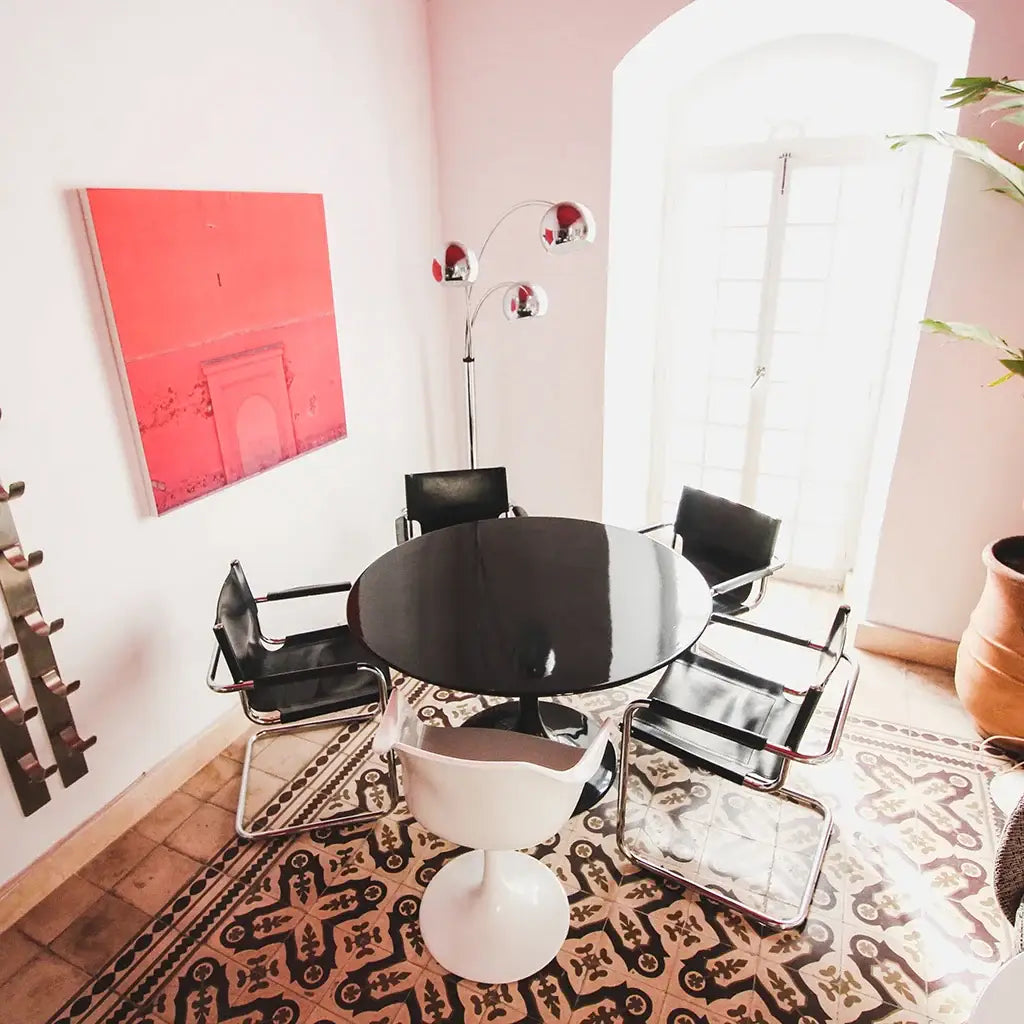
Applying eclectic style in different rooms means tailoring aesthetic adventure to fit distinct functions—without losing coherence. Each room becomes a variation on a theme, a different movement in a domestic symphony. The eclectic ethos doesn’t require every space to echo the same rhythm, but it does insist on intentionality: curated contrast, visual dialogue, and personal narrative embedded in each corner.
In eclectic interiors, style flows not as repetition, but as evolution. The living room may riff on bohemian maximalism; the kitchen may nod toward post-industrial elegance; the bedroom, a cocoon of layered softness. What connects them is not uniformity, but continuity—through tonal threads, materials, or the recurring tension between modernity and nostalgia.
Creating an Eclectic Kitchen and Dining Area
Kitchens are often reduced to pure utility, but an eclectic kitchen resists that austerity. It is a room of choreography—of ingredients and guests, textures and stories. Start with your foundation: maybe sleek concrete counters or butcher block islands. Then layer personality with open shelving, mismatched ceramics, patterned tiles, and collected vintage kitchenware.
-
Introduce a mix of chair designs around a unified dining table—wood, metal, acrylic—so long as one element (color, leg shape, scale) binds them.
-
Add statement lighting: a blown-glass chandelier above a rustic harvest table or retro pendants suspended over a brass-trimmed island.
-
Include global touches: Moroccan zellige backsplash, Delft-style tiles, or woven African baskets turned wall art.
-
Consider cabinet handles and drawer pulls as punctuation—swapping out the expected for mid-century brass, leather pulls, or painted porcelain.
-
Style open shelves with handmade pottery, heritage glassware, and thrifted curios that show your palate’s evolution as well as your palette’s.
This is where form meets function, but neither dominates. Let artistry live beside appliances. Let the unexpected coexist with the everyday.
Eclectic Bedrooms – A Personal Sanctuary
Bedrooms should whisper your interior monologue. Eclectic bedrooms – a personal sanctuary—do not follow catalog logic. They follow emotional gravity.
-
Layer linens in mixed prints: ticking stripe sheets beneath an Indian kantha quilt or block-printed duvet.
-
Pair antique nightstands with ultra-modern sconces. A 1920s armoire next to a steel-frame bed becomes an act of personal contrast.
-
Display small artworks, travel photographs, or sentimental objects like hand-bound books or ceramics on floating shelves.
-
Let your color story soothe: muted plums, pale turmeric, earthy olive, dusty rose—tones that feel inhabited, not staged.
-
Use a combination of task and ambient lighting: vintage table lamps beside reading chairs, paper lanterns above bedside tables.
Don’t be afraid to break symmetry. Let one side of the bed feel distinct from the other. Let asymmetry become personality. Let quiet textures—woven throws, quilted headboards, fringe-edge rugs—bring softness and slow rhythm.
The eclectic bedroom is a container for dreams, not trends. It doesn't ask to be photographed. It asks to be returned to, night after night. In this room, the mix of styles becomes mood. The function becomes feeling. The comfort becomes composition.
Incorporating Global Influences for a Worldly Eclectic Aesthetic
To embrace a worldly eclectic aesthetic is to transform your home into a cartography of culture, curiosity, and collected memory. This isn’t about appropriating motifs or parroting trends—it’s about honoring objects that bear witness to place and ritual, integrating them with intention into your daily space. In the best examples of eclectic home decor, incorporating global influences becomes a form of aesthetic diplomacy: Moroccan textiles drape beside Danish lighting; Indian inlay tables commune with Swedish bentwood; West African mudcloth rests against Bauhaus steel.
A truly global interior doesn’t feel chaotic—it breathes with the rhythm of well-traveled thought. It tells a story not of conquest or curation, but of contact, connection, and reverence. From Japanese wabi-sabi imperfection to Peruvian vibrancy, Zulu beadwork to Venetian mirrorwork, every texture speaks a language. And together, they translate into something wholly your own.
Begin with Authentic Pieces
Start not with reproductions, but with artifacts that carry time in their grain. A Batak carved stool. A hand-thrown Greek amphora. A Berber rug whose dyes were made with henna and saffron. Seek out pieces that weren’t made for export, but for use—ritual, domestic, spiritual. These are the objects that pulse with memory.
Authenticity is not a price tag. It’s presence. Hand-stitched, hand-coiled, hand-dyed, hand-worn. The fingerprint matters. Visit flea markets, antique stores, and diasporic makers. Learn the lineage of the object before assigning it a place in your home.
Balance with Neutral Elements
Don’t over-saturate your space with novelty. Every mask, every woven bowl, every patterned vase carries narrative weight. To let these stories breathe, set them against stillness. Use clay plaster walls, pale terrazzo, concrete floors, or white oak cabinetry as a quiet foundation. Neutral elements aren’t blank—they’re spacious. They give your artifacts room to speak.
-
Anchor ornate décor with linen slipcovers, minimalist shelving, or clean-lined furniture.
-
Resist the urge to crowd every wall—give pieces negative space as if in a gallery.
-
Let global color stories—indigo, paprika, ochre, sienna—unfurl against muted backdrops.
Harmonize through Color and Texture
A global eclectic interior lives in the interplay of texture and hue. Unify disparate pieces through shared tonal resonance—a cobalt Japanese tea set that echoes the glaze of a Moroccan tagine. A woven Bolivian throw whose rust tones mirror an Aboriginal dot painting across the room. This chromatic echo binds continents through color.
Textures too become bridges: the coarseness of jute underfoot complements the embroidery of an Uzbek suzani. Hammered brass from Egypt catches light like a gilded Byzantine frame. From smooth soapstone to hand-chiseled wood, surfaces act like dialects of the same language.
-
Build continuity through repeating textures: three distinct baskets, all handwoven.
-
Establish palette through layering: African indigo, Turkish terracotta, Nordic ash.
-
Let silk and sisal, velvet and raffia, exist side by side in deliberate contrast.
Mix Function with Form
Form needn’t sacrifice function. Let your collected artifacts live beyond the pedestal.
-
A carved African stool becomes a side table beside a modern chaise.
-
An Andean poncho finds second life as a wall tapestry.
-
A Moroccan brass tray rests atop an acrylic base as a coffee table.
Use your décor. Let it age, patina, absorb time. Your home should never feel like a museum—it should feel like a life, deeply lived.
Celebrate the Stories
The worldly eclectic aesthetic thrives on narrative. Every piece deserves to be more than an aesthetic flourish—it should carry memory, provoke conversation, teach geography through material. Display with reverence, not randomness.
-
Frame a Guatemalan huipil like artwork.
-
Mount ceremonial masks at eye level to invite eye contact.
-
Write small notes on the back of frames—where it came from, who gifted it, what it means.
These are heirlooms in waiting. Not souvenirs, but signifiers.
Curate Thoughtfully, Not Excessively
Global influence doesn’t mean maximalism without restraint. Avoid cluttering your home into an anonymous airport lounge of “exotic” items. Instead:
-
Choose fewer pieces with greater significance.
-
Rotate collections seasonally or by mood.
-
Let certain pieces rest, then return them when your eye craves their shape again.
This isn’t static design—it’s a living archive of your aesthetic evolution. Your home becomes an atlas where the spine is your own taste. The more intentional your global references, the more magnetic and meaningful your eclectic interior becomes.
Eclectic Decor Trends to Watch
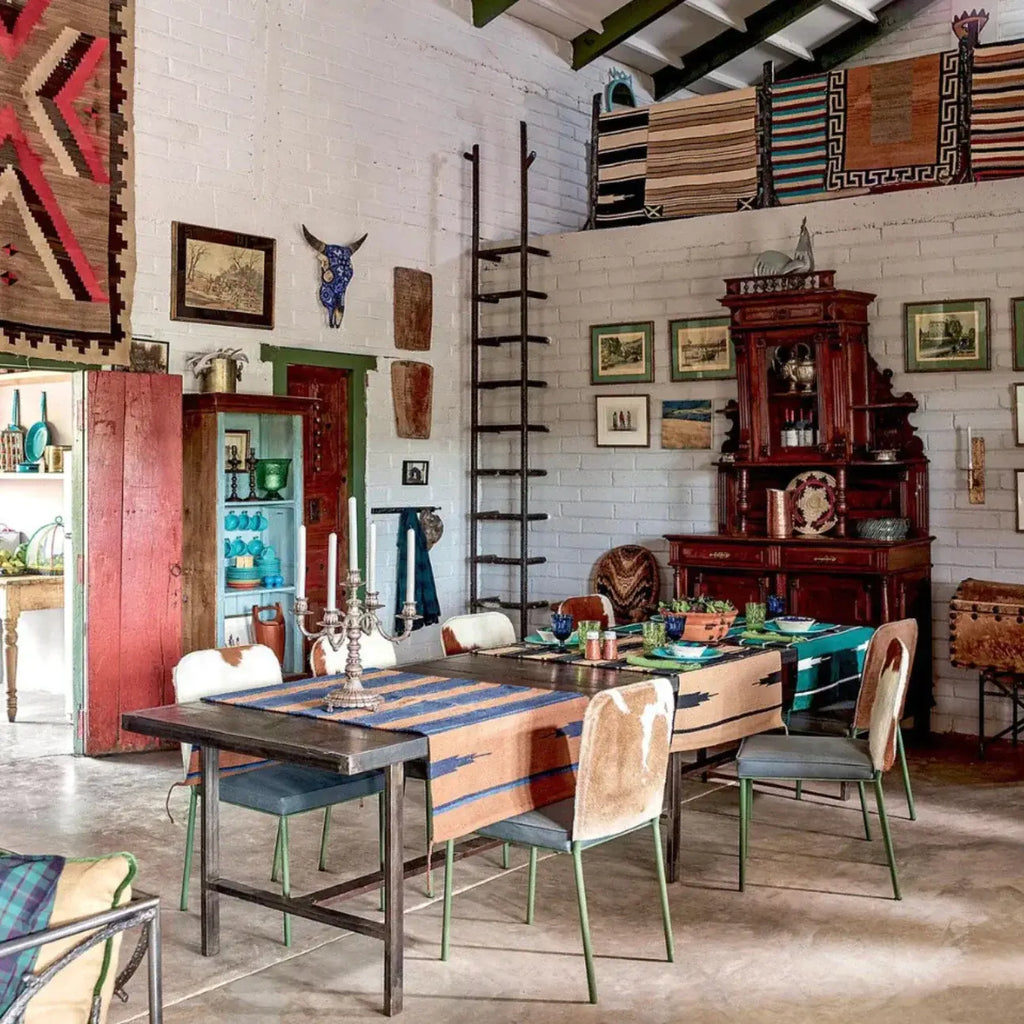
@ericpiasecki for @houseandgardenuk
In a design world that often cycles between monochromatic austerity and algorithm-approved minimalism, eclectic decor trends surge forward like a heartbeat—erratic, alive, and human. These trends aren’t forecasts for the fickle. They’re barometers of desire. Of people wanting homes that feel like biographies, not catalogues. The aesthetic is still maximal, but it's grown more nuanced. Less “anything goes,” more “everything meaningful.”
What unites this new wave isn’t any single style—it’s the rejection of design orthodoxy. It's a celebration of imperfection, personalization, and cultural cross-pollination. In 2024 and beyond, eclectic home design continues to gather momentum through layered nostalgia, ethical sourcing, and the unexpected harmonies of old and new, mass-made and artisanal.
Here are the rising motifs, materials, and philosophies reshaping eclectic spaces:
Nostalgic Revival
The past is not behind us—it’s been repurposed. Today’s interiors favor meaningful relics over mass-produced clones. Think: family china mixed with mid-century Danish sideboards, embroidered linens inherited from grandparents styled beneath abstract resin art.
-
Retro palettes are back, but with a twist: avocado green and burnt sienna reappear beside polished chrome and alabaster tones.
-
Upcycled vintage finds—console radios, bar carts, wicker peacock chairs—are reimagined as sculptural anchors.
-
Old-world craftsmanship is newly treasured: hand-carved trims, embroidered drapery, artisanal patchwork quilts.
Global Fusion
Global influence is no longer decorative—it’s relational. Interiors nod to lived experiences and hybrid identities.
-
Indonesian batik pillows rest on Bauhaus daybeds.
-
A Senegalese woven fan adorns a whitewashed gallery wall.
-
Indian block prints layer into rooms otherwise stripped and monochrome.
These aren’t tokens—they’re threads in a larger cultural fabric. Travel is not just inspiration—it’s inventory. And authenticity matters more than aesthetic sampling.
Sustainable and Artisan
As mass production loses its luster, artisan craftsmanship and sustainable design become badges of intention.
-
Interiors now prioritize hand-thrown ceramics, repurposed barnwood, and naturally dyed textiles.
-
Designers and homeowners alike seek small-batch, fair-trade, and locally sourced decor elements.
-
Wabi-sabi aesthetics—celebrating imperfection, asymmetry, and aging—meld beautifully with the eclectic palette.
The focus is not just how things look, but how they were made. Provenance becomes part of the appeal.
Layered Maximalism
Maximalism grows more refined, no longer equated with visual overload. Instead, it's about narrative layering—where every piece carries weight, but never competes.
-
Juxtaposed styles—Victorian beside postmodern, brutalist with romantic—create a kind of tension that invites engagement, not overwhelm.
-
Patterns clash deliberately: ikat against chevron, toile beside terrazzo.
-
Books, objects, and art are arranged like visual poems—not cluttered, but constructed.
Biophilic Elements
Organic materials and plant life continue to flourish in eclectic interiors, but now with more subtlety.
-
Indoor trees like fiddle-leaf figs and olive plants offer sculptural greenery.
-
Driftwood, clay, linen, stone—materials with tactile honesty—ground even the most daring compositions.
-
Water elements, diffused light, and textured walls replicate the softness of nature inside manmade environments.
Embracing These Trends
Start with small gestures. One artisan lamp, one found textile, one bold art piece. Let your home evolve, accreting style the way coral accretes color—over time, organically, beautifully flawed.
In the most compelling eclectic interiors, these trends don’t dominate. They hum beneath the surface—subtle movements, quiet rebellions. Trends are fleeting. But when they align with intention, they become tools for meaning.


